
Many Nikon fans don't like 'G' lenses, because they mark a hard cut in terms of backward compatibility. Nikon had already planned such lenses in the 80s, but the first real sample was introduced in Y2K (it was a consumer AF-Nikkor 70-300mm f/4-5.6 G). All the former 'G' lenses were AF lenses, either with a screwdriver coupling or with an integrated AF drive. 'G' lenses send a distance information to the camera like AF-D lenses do.
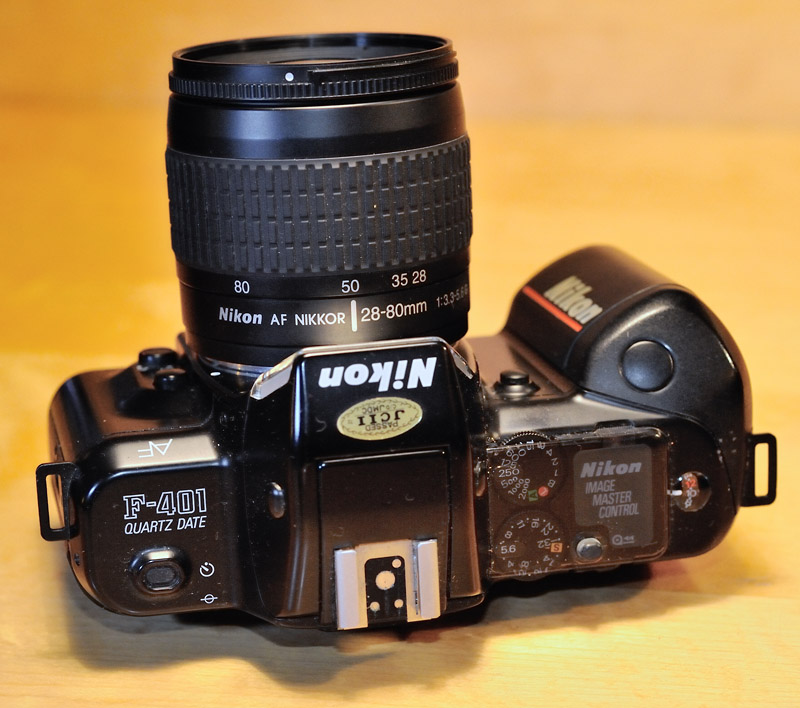
|
|
A happy relationship despite the age disparity! The F-401 from 1987 was Nikon's first camera body with CPU interface only. Mounted is one of the first lenses with CPU interface only, the AF Nikkor 28-80mm f/3.5-5.6 G from around 2002. |
'G' lenses works fine in conjunction with every Nikon DSLR. The only restriction is commonly known: the cheaper bodies (such as D40, D60, D3000, D3100, D3200, D5000, D5100, D5200) can't autofocus a lens with a screwdriver coupling. Most of the screwdriver 'G' lenses are cheap zooms, designed for analogue cameras. The only 'serious' lens of this type I remember is the Fisheye Nikkor 10.5mm f/2.8 G DX.
An advantage of the more expensive 'G' lenses over AF lenses with an aperture ring is the weather sealing around the mount.
You can mount a 'G' lens on a non-CPU camera, but that makes an almost useless combination! Due to the lack of an aperture ring you will photograph at the smallest possible aperture all the time (e.g. with the AF-S Nikkor 50mm f/1.8 G you always shoot with F16). Even on non-CPU cameras that offer P or S exposure mode (FG, FA, F-301/N2000), a 'G' lens is not usable, because it lacks all the neccessary coupling elements for that!
'G' lenses are usable on every camera with CPU interface except for the F-501 (US: N2020) and the F-601 (US: N6006).
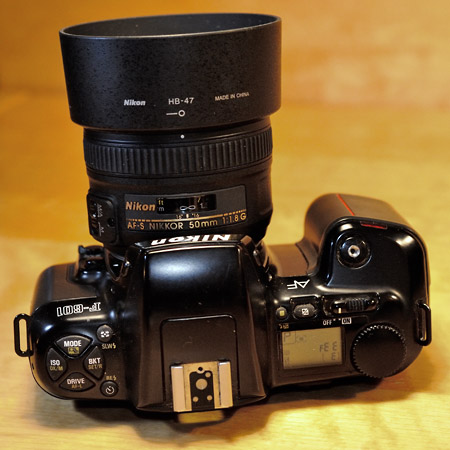
|
|
FE.E - The 'G' bug of the F-601. |
The F-501 from 1986 is a unique camera. It uses it's CPU interface only for AF purposes. For metering and exposure modes the F-501 uses a mechanical interface, inherited from the F-301 (US: N2000). That is great, because it is the only AF camera that allows the P exposure mode with non-CPU lenses. But that is bad, because it needs the mechanical coupling elements that 'G' lenses lack.
In the manuals of 'G' lenses you can find the information that the lens is not compatible with the F-601, but is usable with the F-601M (US: N6000). That's curious, because both models were introduced together in 1989 as the successors of the F-501/F-301. After getting my first full format 'G' lens I wanted to check what's going on here. I bought both cameras for a few euros on ebay. Indeed, the F601M works fine in conjunction with a 'G' lens (of course, with the expected restrictions, see below). But on the F-601 (set to P mode) the error "FE.E" is displayed (we know this error from a mounted AF-lens that is not set to the smallest aperture). I found only one explanation for this behaviour: the F-601 has a firmware bug!
Restrictions in terms of exposure modes exists only for a very few older cameras that do not allow to control the aperture from the camera, as it is usual today. These cameras are the F-801/N8008, F4, F-601M/N6000, F90/N90, F70/N70, F90x/N90s. A and M modes make no sense here, because you would work all the time at the smallest possible aperture. In contrast, the S and P modes work fine.
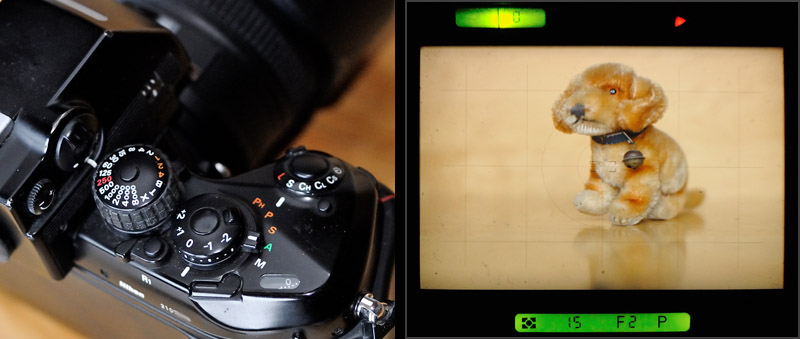
|
|
A nice detail can be observed on the F4: if the camera is set to M or A mode and a 'G' lens is mounted, the F4 switches automatically to P mode. Because there is no display on the top you have to look through the finder to notice that switching. |
Another restriction is the AF system. In the early times every camera supported the screwdriver AF, but only the expensive ones supported the internal AF drive. The F-401/N4004, F801/N8008, F50/N50, F60/N60 does not. As mentioned above, today things are reversed. Cheaper cameras do not support the screwdriver AF.
Many people think a 'G' lens is the same as an AF lens with a locked aperture ring. Indeed, from a user point of view it is true for many cameras. Technically it is wrong! There is a property in the lens data that tells the camera that it is a 'G' lens.
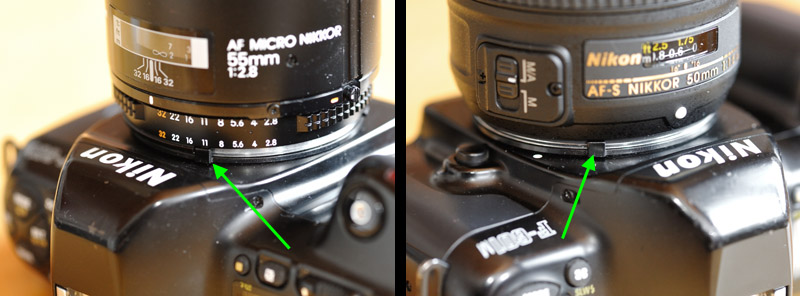
|
|
If a CPU lens with an aperture ring is mounted to a camera with both AI and CPU interface, the camera knows the number of F-stops between the lowest and the highest aperture value by reading the lens data. Then it can read the position of the AI tab to check if the lens is set to the smallest aperture. If a 'G' lens is mounted, the AI tab is not touched in any way. The camera knows from the lens data that it is a 'G' lens (that is always set to the smallest aperture). The camera shown here is an F-601M. |
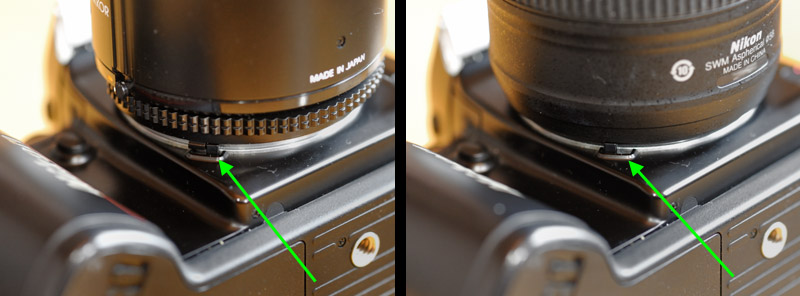
|
|
A camera with a CPU interface only (shown here an F-401) has a small lever near the F-Mount. If a CPU lens ist mounted and if it is set to the minimum aperture, the EE servo coupling post (originally designed for the DS-12 "Electric Eye" unit, which makes the F2AS to a camera with shutter priority automatic mode) of the lens touches the lever. A 'G' lens does not touch the lever. Therefore even cameras with a CPU interface only must read the 'G' property from the lens data. |
If the camera recognises a CPU lens with an aperture ring and the aperture should be controlled from the camera (e.g. in P mode), the lens' aperture ring must be set to the highest value. The camera checks it in a mechanical way. If a 'G' lens is mounted, there is no such mechanical message. Exactly at this point the F-601 has its bug. If you move the AI-tab of the F-601 by hand to a virtual high aperture value, a 'G' lens works fine. But before you go on ebay to buy an F-601, be warned: you will need additional and very small fingers if you want to photograph with a F-601 and your 'G' lens ;)
Currently I own five 'G' lenses. Below you can see an image of their mounts.
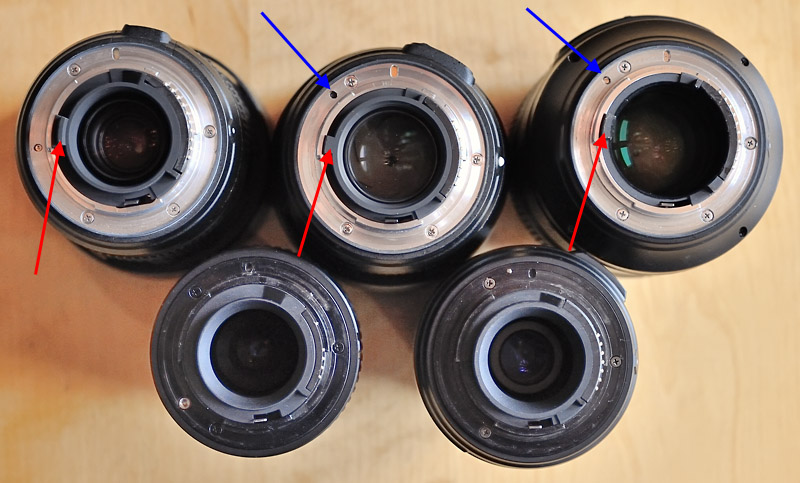
|
|
Upper row, from left to right: AF-S Nikkor 18-70mm f/3.5-4.5 G DX, AF-S Nikkor 50mm f/1.8 G, AF-S Micro-Nikkor 105mm f/2.8 G VR. Lower row: AF Nikkor 28-80mm f/3.5-5.6 G, AF-S Nikkor 18-55mm f/3.5-5.6 G DX. |
There are two significant differences between the two plastic fantastic lenses and the "better" ones with a metal mount (not counting the weather sealing here):